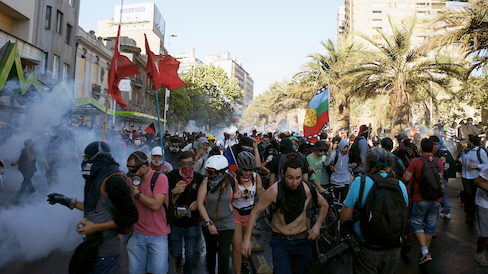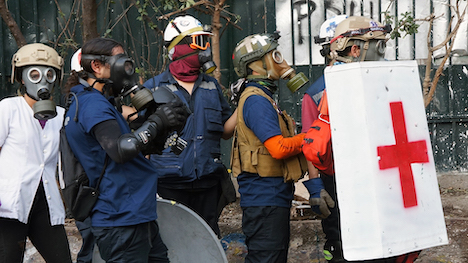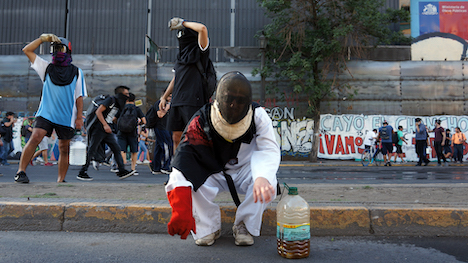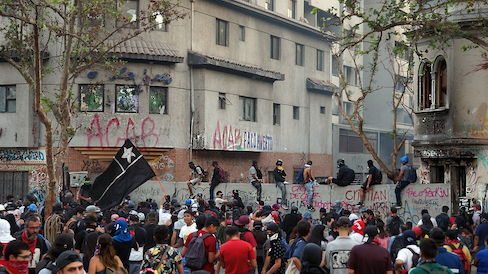Teargas is banned in warfare, it should not be used on the public
 Print This Print This
By Naomi Larsson | Toward Freedom
from Toward Freedom
Friday, Jul 10, 2020
You see a cloud of smoke, and there’s something almost alluring about its candy floss shape. But then it hits. Your throat itches, it feels like the muscles inside are expanding and you struggle to breathe. Then there’s pain in your eyes, you begin to cry but the tears make the pain worse. With your body weak from confusion, your head throbbing, you fall to the ground.
 |
|
Protesters run as police fire teargas in central Santiago, Chile, on December 27, 2019. Photo: Daniel Espinoza Guzmán. |
Teargas is a chemical weapon that is banned in warfare, according to the 1925 Geneva Protocol and the 1993 Chemical Weapons Convention. And yet the United States is using tear gas and other “non-lethal” weapons against crowds of people protesting anti-Black racism and police violence. Like in many other countries, tear gas is considered an acceptable form of crowd control.
Seen from England, the protests against the police killing of George Floyd appear as a continuation of a long tradition of Black-led struggle against stark inequality, deeply entrenched racism, and state terror. This is in no way isolated to the US: thousands of people in London and cities across the UK are taking the streets in solidarity.
The protests began over racist police brutality. The police response has validated the urgency of the struggle.
 |
| Some of the more than 1,000 police gathered on December 18, 2019 before demonstrators arrived following the announcement a crackdown on protests in Santiago de Chile. Photo: Daniel Espinoza Guzmán. |
On May 30th, the New York Police Department drove an SUV through a crowd in Brooklyn. Police also shot at journalists. They fired non-lethal rounds at people outside their own homes. In Louisville, Kentucky, David McAtee was killed by National Guard gunfire. Police pepper-sprayed an Ohio Congresswoman. A pregnant woman was shot in the belly and another man is in critical condition after being shot in the head with rubber bullets in Austin, Texas. A photographer was blinded in one eye. This appalling list grows longer every day.
I was in Chile when the mass protests erupted against neoliberalism and precarity last October.
In Chile, which has had a heavily militarized police force following its 17-year dictatorship, teargas, water cannon and “non-lethal” firearms are the first response to mass demonstrations. In the protests that took place daily in Santiago, where I was living, the air and ground were charged with toxic chemicals. It became difficult to breathe even when gas hadn’t been fired for a day. It seemed to stick to the grass, the soil, and our bodies.
Over days, weeks, and months, Chilean forces shot teargas canisters, rubber bullets and pellets at close range. Between October and March, when protests diminished because of the pandemic, police shot at people’s upper bodies and faces, fully blinding two people, and causing severe eye traumas and partial blindness in at least 450 people. Teargas canisters to the head can cause cranial fractures, and at least one victim was left with a severe brain injury.
 |
| A volunteer first aid team in Santiago de Chile in February, 2020. Photo: Daniel Espinoza Guzmán. |
We are witnessing similar responses to the crowds in the US. I fear for all of those who are on the ground.
The people on the streets today in the US are exercising their rights to protest and to free speech, both of which are so well protected when it suits the right people. But in doing so against police violence and white supremacy, these protesters are risking their lives.
Going to a protest in the US today means you might not come home, or you might return with life-changing injuries. This is already the violent reality for African Americans, and this is why the protests against the killing of George Floyd are exploding.
Teargas canisters and rubber bullets can kill. They should not be classed as “non-lethal.”
 |
| A mata lacri or gas killer rests on December 20, 2019 in Santiago. Mata Lacris disable tear gas canisters, allowing other demonstrators to assemble peacefully. Photo: Daniel Espinoza Guzmán. |
While I was in Santiago in the fall, I felt the pain and toxicity of gas, experienced the force of a water cannon, and heard the piercing shots of rubber bullets pass by me. This in itself causes severe mental trauma, let alone physical. I have seen the wounds these bullets inflict on people’s flesh. I have seen and recorded accounts of how they pierce and explode eyeballs.
“Crowd control” weapons cannot be used against the public. Protesters only have their voices to fight chemical weapons and bullets. It is a dangerous and horrifying imbalance, especially in the context of a pandemic.
 |
| The front line sits on a wall financed by a private businessman to prevent protestors from accessing the Alameda of Santiago and to allow cops a strategic advantage. March 13, 2020. Photo: Daniel Espinoza Guzmán. |
In Chile, international human rights groups investigated the violations inflicted against protesters and the results were damning. Protesters were left to support one another on the streets. Volunteer medical groups and human rights observers emerged. We saw the strength of the primera linea, or “front line,” in which a group of young protesters would organize to protect the crowd behind them from being gassed or abused by police.
International action did little to change police behaviour in Chile, but self-organization among protestors did help keep them safe.
Source URL
|
 Print This Print This

|

